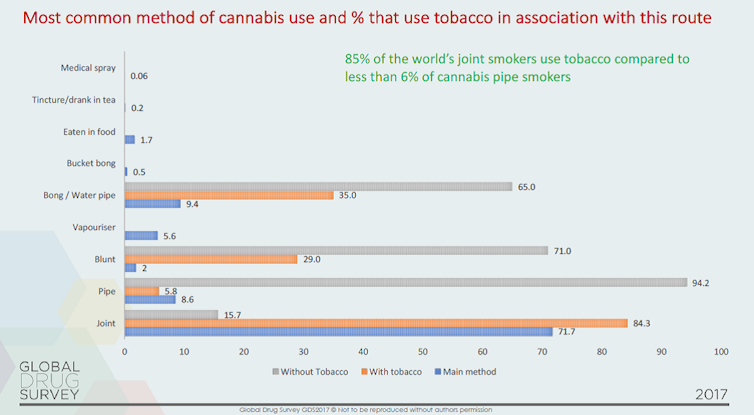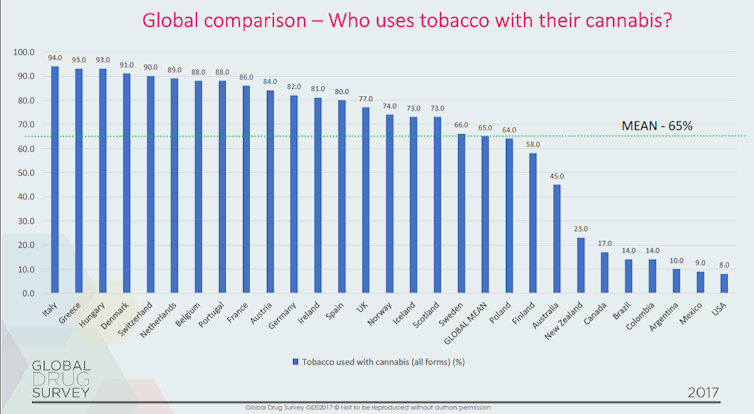Cannabis isn’t the health problem – the tobacco people mix with it is.
Europe may seem like an increasingly divided continent, but there is one thing that unites its people: an obsession with using tobacco to smoke cannabis. Up to 90% of European cannabis users smoke it with tobacco, according to the latest Global Drug Survey. By comparison, only 8% of Americans smoke cannabis this way.
Cannabis is illegal in many European countries – and it has known harms, but the reality is that many people use the drug anyway. Consequently, policy needs to reflect this reality.
For many Europeans, cannabis is a gateway drug to tobacco as many people are first exposed to tobacco when they smoke their first joint, a phenomenon referred to as the reverse gateway effect.
Smoking (combusting) anything is bad for your lungs. Smoking changes the properties of a substance, often forming toxic and carcinogenic compounds. For cannabis this includes brain changes that are thought to impair cognitive functioning, particularly in adolescents. And the harmful effects of smoking tobacco are well known. More than 8m people die each year as a result of smoking tobacco – mostly from cancer and cardiovascular disease.
But you don’t have to smoke cannabis with tobacco to enjoy the benefits. Alternatives to smoking cannabis include eating it – sometimes referred to as edibles – and inhaling via a vaporiser, pipe or bong.

Joints are not the only way
Countries such as the US and Canada have a cultural disdain for combining tobacco with cannabis. Sweeping regulatory reforms, commercialism and a diversity of concentrated cannabis products have lent themselves to a gradual move to vaping.
There is now sufficient evidence to promote vaping as an healthier alternative method for cannabis. Vaping devices contain an element that heats the cannabis (bud or oil) to a temperature that turns the active ingredients, THC (tetrahydrocannabinol) and CBD (cannabidiol), into a vapour, but without burning it. Smokers need to take smaller and fewer hits to get the high than joint smokers.

In countries where smoking joints is the norm, we need to focus on harnessing the success of anti-tobacco smoking campaigns to help people who like smoking cannabis to do so without tobacco.
Framing drug use as a health issue, rather than a criminal justice issue, is key. Apart from the moral arguments supporting such a shift there are clear economic gains. In the UK, research commissioned by the Liberal Democrats shows that it costs the taxpayer £2,256 for the police to deal with each case of cannabis use. An estimated £67m – spent treating tobacco-related health problems – could also be saved if the next generation of tokers grows up tobacco free.
Legalisation may not cut tobacco use
Before people start calling for law reform, legalising cannabis won’t necessarily be the solution to the issue either. The Netherlands has one of the highest rates of smoking with tobacco in the world, despite a more tolerant approach to drug use.
Changing cultural consumption norms of any substance is difficult. Many people in the UK still binge drink despite not having to be out of the pub at 11pm. Change requires governments to respect the choices individuals make. People who smoke cannabis should be offered practical advice on how to get high without smoking tobacco, rather than be legislated against. The government might also want to consider repealing the law that bans the sale of dry herb vaporisers. Changing norms may take a while, but this would be a good start.
Governments have a duty to protect people. Denying or ignoring the health risks this group face helps no one.
This originally appeared at https://theconversation.com/cannabis-isnt-the-health-problem-the-tobacco-people-mix-with-it-is-77067
